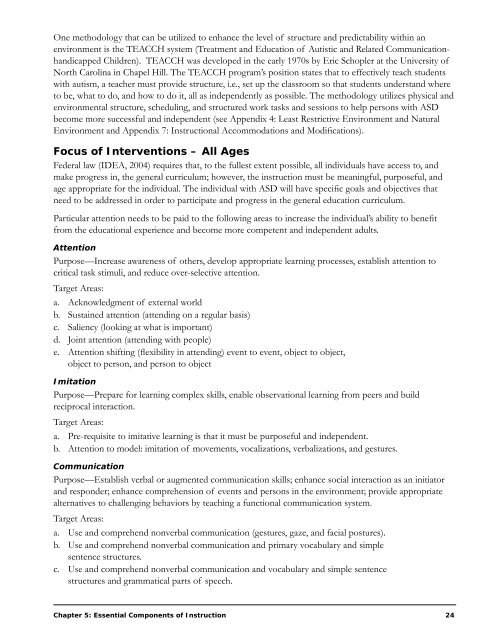Autism Guidebook for Washington State - Health Education ...
Autism Guidebook for Washington State - Health Education ...
Autism Guidebook for Washington State - Health Education ...
You also want an ePaper? Increase the reach of your titles
YUMPU automatically turns print PDFs into web optimized ePapers that Google loves.
One methodology that can be utilized to enhance the level of structure and predictability within an<br />
environment is the TEACCH system (Treatment and <strong>Education</strong> of Autistic and Related Communicationhandicapped<br />
Children). TEACCH was developed in the early 1970s by Eric Schopler at the University of<br />
North Carolina in Chapel Hill. The TEACCH program’s position states that to effectively teach students<br />
with autism, a teacher must provide structure, i.e., set up the classroom so that students understand where<br />
to be, what to do, and how to do it, all as independently as possible. The methodology utilizes physical and<br />
environmental structure, scheduling, and structured work tasks and sessions to help persons with ASD<br />
become more successful and independent (see Appendix 4: Least Restrictive Environment and Natural<br />
Environment and Appendix 7: Instructional Accommodations and Modifications).<br />
Focus of Interventions – All Ages<br />
Federal law (IDEA, 2004) requires that, to the fullest extent possible, all individuals have access to, and<br />
make progress in, the general curriculum; however, the instruction must be meaningful, purposeful, and<br />
age appropriate <strong>for</strong> the individual. The individual with ASD will have specific goals and objectives that<br />
need to be addressed in order to participate and progress in the general education curriculum.<br />
Particular attention needs to be paid to the following areas to increase the individual’s ability to benefit<br />
from the educational experience and become more competent and independent adults.<br />
Attention<br />
Purpose—Increase awareness of others, develop appropriate learning processes, establish attention to<br />
critical task stimuli, and reduce over-selective attention.<br />
Target Areas:<br />
a. Acknowledgment of external world<br />
b. Sustained attention (attending on a regular basis)<br />
c. Saliency (looking at what is important)<br />
d. Joint attention (attending with people)<br />
e. Attention shifting (flexibility in attending) event to event, object to object,<br />
object to person, and person to object<br />
Imitation<br />
Purpose—Prepare <strong>for</strong> learning complex skills, enable observational learning from peers and build<br />
reciprocal interaction.<br />
Target Areas:<br />
a. Pre-requisite to imitative learning is that it must be purposeful and independent.<br />
b. Attention to model: imitation of movements, vocalizations, verbalizations, and gestures.<br />
Communication<br />
Purpose—Establish verbal or augmented communication skills; enhance social interaction as an initiator<br />
and responder; enhance comprehension of events and persons in the environment; provide appropriate<br />
alternatives to challenging behaviors by teaching a functional communication system.<br />
Target Areas:<br />
a. Use and comprehend nonverbal communication (gestures, gaze, and facial postures).<br />
b. Use and comprehend nonverbal communication and primary vocabulary and simple<br />
sentence structures.<br />
c. Use and comprehend nonverbal communication and vocabulary and simple sentence<br />
structures and grammatical parts of speech.<br />
Chapter 5: Essential Components of Instruction 24
















